Pride flags are more than colorful banners — they are powerful symbols of identity, visibility, and resistance for LGBTQ+ folks around the world. While the rainbow Pride flag remains the most widely recognized, many other flags represent the rich diversity of gender identities and sexual orientations within the LGBTQ+ community worldwide. They represent the diversity and unity within the community, serving as a visual reminder of the struggles and triumphs of the queer movement. Each flag has its own extraordinary meaning and LGBTQ+ history. From the trans and intersex flags to symbols for polyamory, non-binary, lesbian, and Two-Spirit people, each flag tells a unique story of inclusion, struggle, and pride. Whether you’re looking for the flag that reflects your identity or want to understand the beautiful diversity of queer symbols better, our Couple of Men guide will help you appreciate the significance of each LGBTQ+ Pride flag in today’s inclusive world.
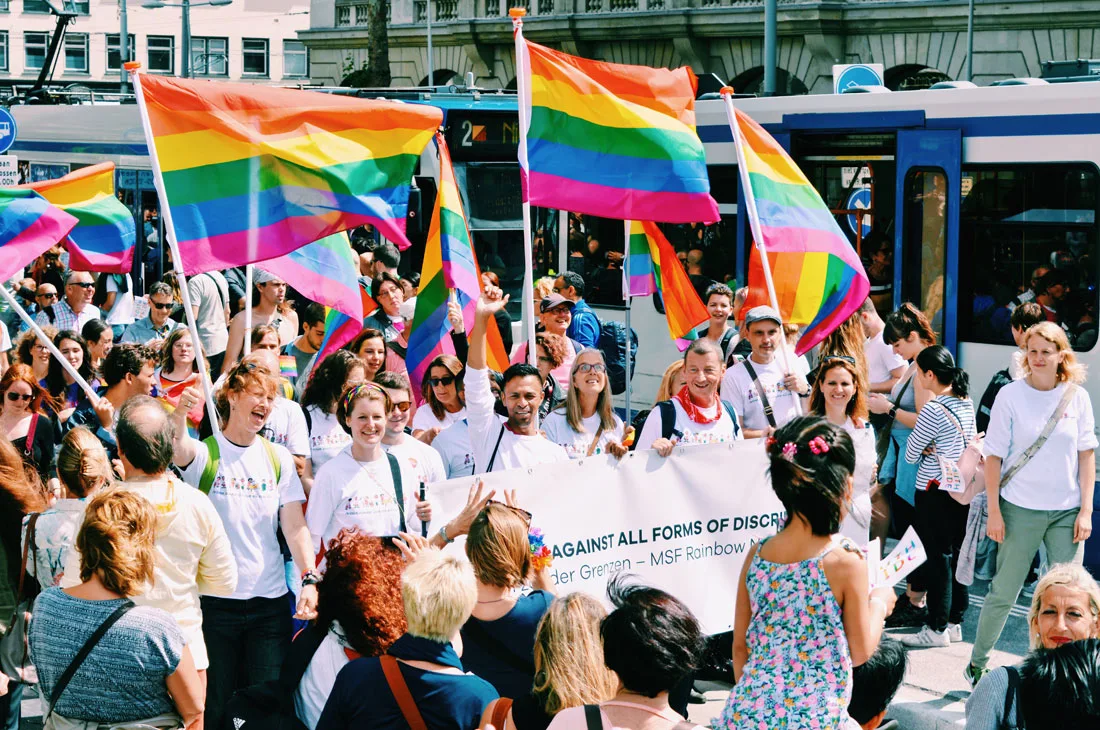
Why Pride Flags Matter in the LGBTQ+ Community
The LGBTQ+ community is incredibly diverse, spanning a broad spectrum of sexualities, gender identities, and romantic orientations. Pride flags offer visibility and validation for people who have historically been marginalized or erased, particularly transgender, intersex, non-binary, and bisexual individuals. These symbols serve not only as statements of queer pride but also as visual tools for activism, protest, celebration, and education. Understanding the meanings behind LGBTQ+ Pride flags helps build empathy and connection within and beyond the queer community. Let’s explore the most widely recognized and meaningful queer identity flags, one by one.

Rainbow Flag: History of the LGBTQ+ Flags
The rainbow flag is the most well-known and recognizable pride flag. The rainbow pride flag was first designed in 1978 by Gilbert Baker, a gay rights activist and artist from the United States of America. Baker was approached by Harvey Milk, one of the first openly gay elected officials in the United States, to create a symbol that would represent the gay community. The original flag had eight colors, each with its own meaning: pink for sexuality, red for life, orange for healing, yellow for sunlight, green for nature, turquoise for magic, blue for serenity, and purple for spirit.
Over time, the pink and turquoise stripes were removed due to fabric availability, leaving the six colors we recognize today. The rainbow flag quickly gained popularity as a symbol of gay pride and solidarity. It was flown at the San Francisco Gay Freedom Day Parade in 1978, and soon after, it became an international symbol of LGBTQ+ rights. Today, the rainbow flag is widely recognized as a symbol of diversity and inclusivity for the LGBTQ+ community.
Advertisement
KLM Flight Offers
Fly with our partner airline, the gay-friendly KLM Royal Dutch Airlines, and its partners Air France and Delta Air Lines in Economy, Premium Comfort and Business Class to LGBTQ+ welcoming destinations worldwide.
All LGBTQ+ Pride Flags are important!
While the rainbow flag is a global icon, it is just one among many LGBTQ+ Pride flag meanings that reflect the diversity within the queer community. Each flag offers a unique perspective on gender and sexuality, fostering inclusion and recognition. These inclusive Pride symbols uplift marginalized voices and help promote understanding across the LGBTQ+ spectrum.
“I say the rainbow flag is like the American flag: everybody’s underneath that, but each group, like each state, has their own individual flag.”
Monica Helms – creator of the transgender flag in 1999
#1 Progress Pride Flag 2018 (by Daniel Quasar)
The Progress Pride Flag is a modern adaptation of the rainbow flag, and it is one of the most significant symbols of inclusivity for the LGBTQ+ community. It was designed to be more inclusive and increase the visibility of non-binary, transgender individuals and people of color within the LGBTQ+ community. Created in 2018 by Daniel Quasar, this gender and sexuality flag features the traditional six colors of the Rainbow flag, along with a chevron of black, brown, light blue, pink, and white. The redesign of the universally recognized LGBTQ+ Pride flag is met with mixed responses from the queer community to this day. On the one hand, Gilbert Baker’s version should be inclusive of all community members.

On the other hand, some community members expect it would provoke a possible split or division within the community. In contrast, queer people from the addressed, marginalized groups from people of color, non-binary communities, and transgender individuals and their supporters welcome the boosted visibility.
#2 Progress Pride Flag 2021 (by Valentino Vecchietti)
Incorporating the intersex flag, Valentino Vecchietti from Intersex Equality Rights UK redesigned the Progress Pride Flag in 2021. The new design acknowledges intersex representation in LGBTQ+ Pride flags, featuring a yellow triangle with a purple circle that has been added to the chevron of the Progress Pride flag. The color green was also modified to a lighter shade without introducing new symbolism. Intersex Equality Rights UK shared the redesigned flag on their Instagram and Twitter accounts. The new intersex-supportive version of Valentino Vecchietti’s 2021 Progress Pride Flag received a similarly divided response as the Progress Pride Flag from 2018. However, it emphasizes the importance of queer flag design, which continues to evolve and include more identities.
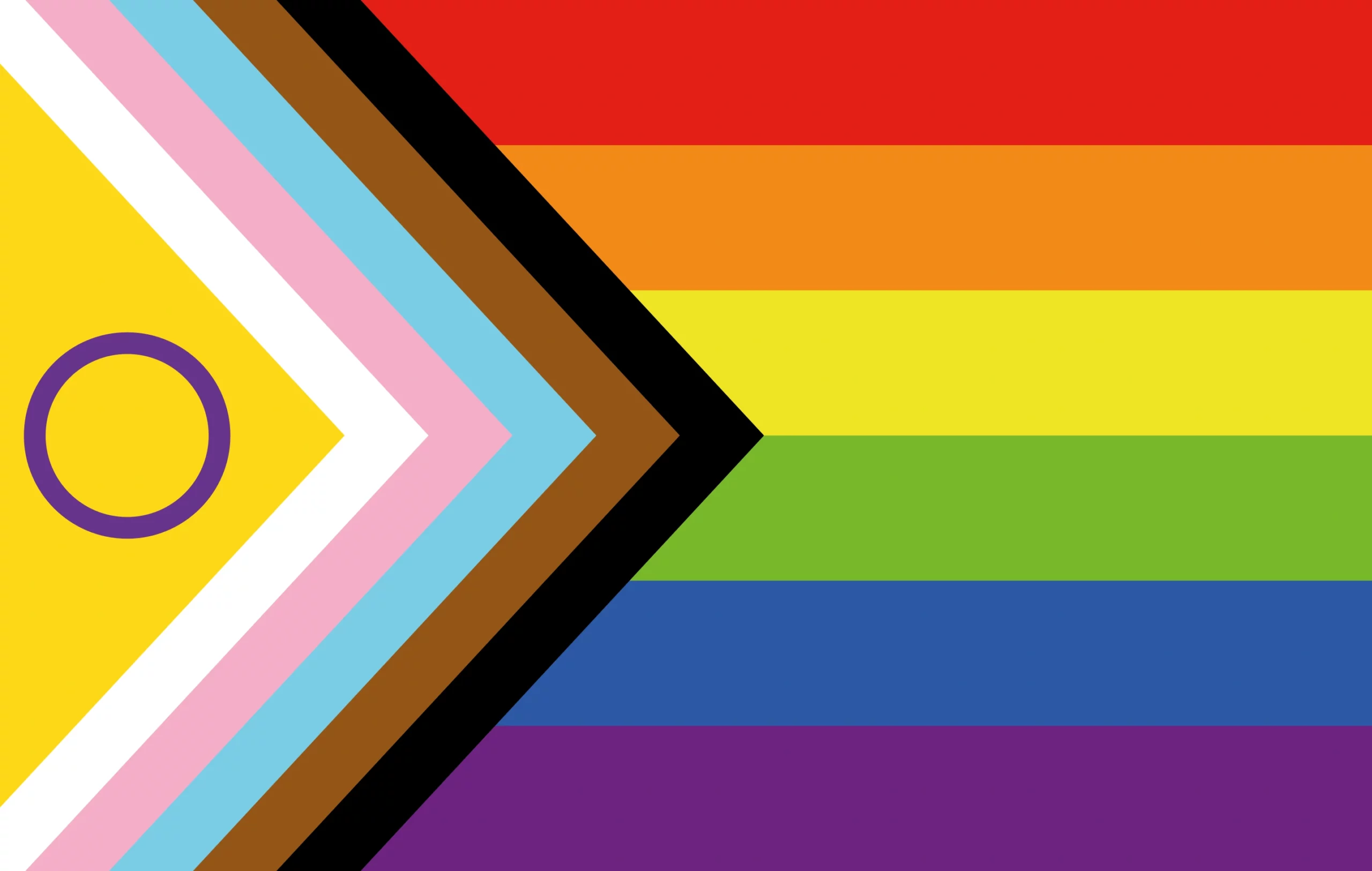
#3 Transgender Pride Flag
The transgender Pride flag, one of the most recognized gender-diverse LGBTQ+ flags, was created by Monica Helms in 1999. It consists of five colors: light blue, pink, white, pink, and light blue. Light blue represents the traditional color for baby boys, pink represents the traditional color for baby girls, and white represents those who are intersex, transitioning, or consider themselves to have a neutral or undefined gender. This flag, designed to represent the transgender community and to provide them with a symbol of pride and visibility, has become a vital queer flag guide for understanding trans visibility.

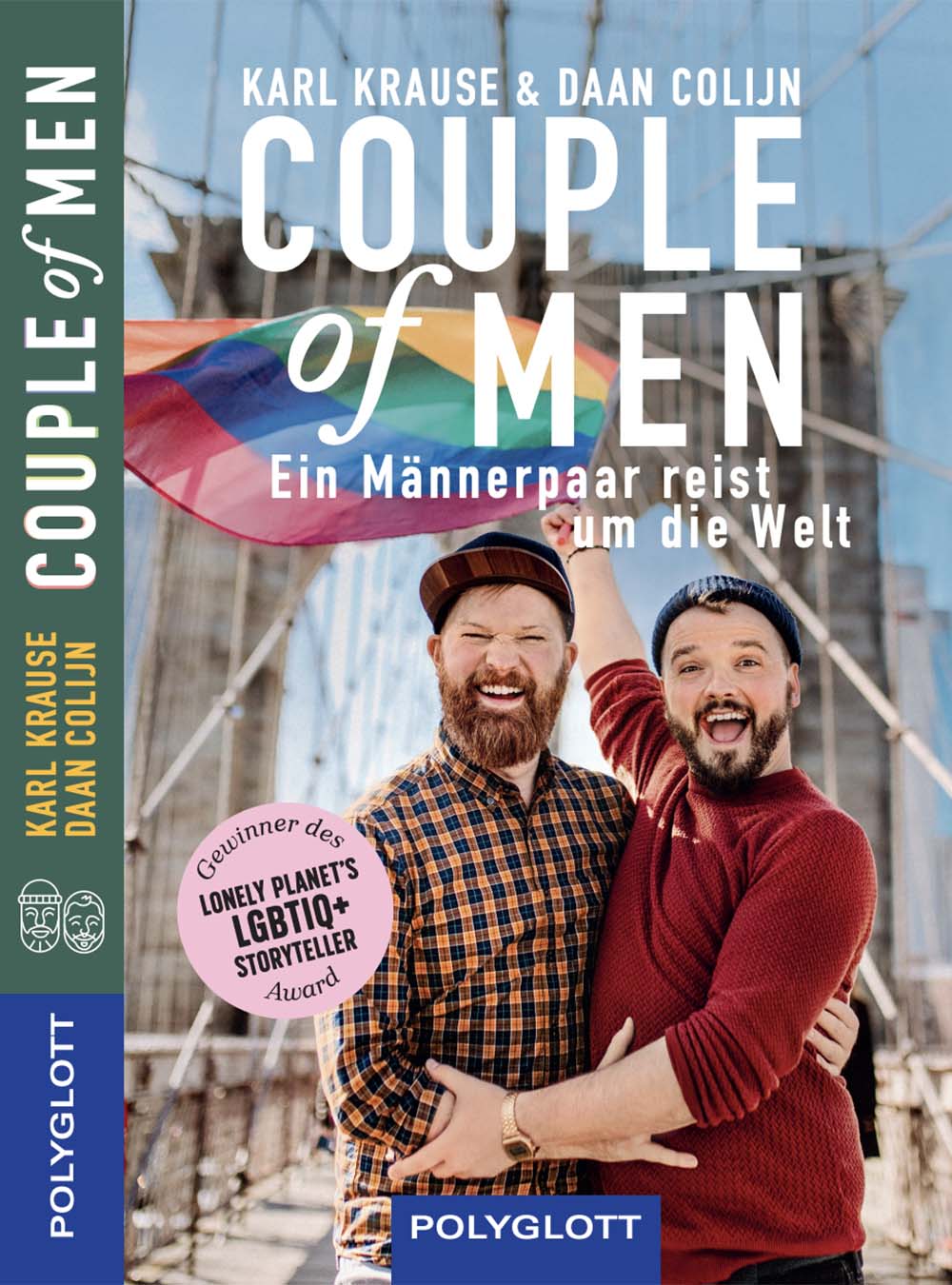
Advertisement
Order our book now!
The perfect present to inspire (German-speaking) LGBTQ+ travelers and their allies to travel the world open-minded, respectfully, and with a happy heart.
Order our book online or purchase it in bookstores in Germany, Austria, and Switzerland.
#4 Intersex Pride Flag
The intersex pride flag features a yellow background with a purple circle in the center, chosen in 2013 by Morgan Carpenter, an intersex activist from Australia. The colors were selected because they do not align with traditional binary identities. The circle in the flag symbolizes wholeness and completeness, representing intersex individuals’ potential and autonomy. The flag is not intended to represent differences in sexual or gender identities. Instead, it serves as a reminder that intersex people, who are born with biological sex characteristics that don’t fit typical male or female categories, are whole and perfect just as they are, regardless of societal norms or pseudoscientific claims. This colorful LGBTQ+ symbol focuses on autonomy and non-binary biology, offering vital visibility to intersex people.
#5 Bear Pride Flag
The Bear Pride Flag, part of the broader collection of LGBTQ+ identity flags, represents the International Bear Brotherhood community. The Bear Pride Flag was created in 1995 and is a symbol of the bear community, which includes gay, bisexual, and transgender men who are typically larger and hairier than the average (gay) man. The LGBTQ+ pride flag features various shades of brown and black, representing the fur of a bear, and a paw print in the top-left corner.
#6 Leather Pride Flag
The leather pride flag was created in 1989 by Tony DeBlase, a leather activist from the United States. The flag features nine horizontal stripes of black, blue, and white, with a red heart in the upper-left corner. The flag’s colors represent different aspects of the leather community, including black for BDSM, blue for service and devotion, and white for purity and liberation. The red heart in the corner represents the love and passion within the community. Though not exclusive to LGBTQ+ individuals, it’s often included in Pride flag guides for its popularity within queer kink spaces.
#7 Lesbian Pride Flag
The lesbian pride flag was created in 2010 by Natalie McCray, and it consists of three colors: orange, pink, and white, and is one of several sexuality-specific Pride flags. The orange represents healing, the pink represents femininity, and the white represents identity. The flag was designed to represent the unique experiences and struggles of lesbians, providing them with a symbol of pride and visibility.
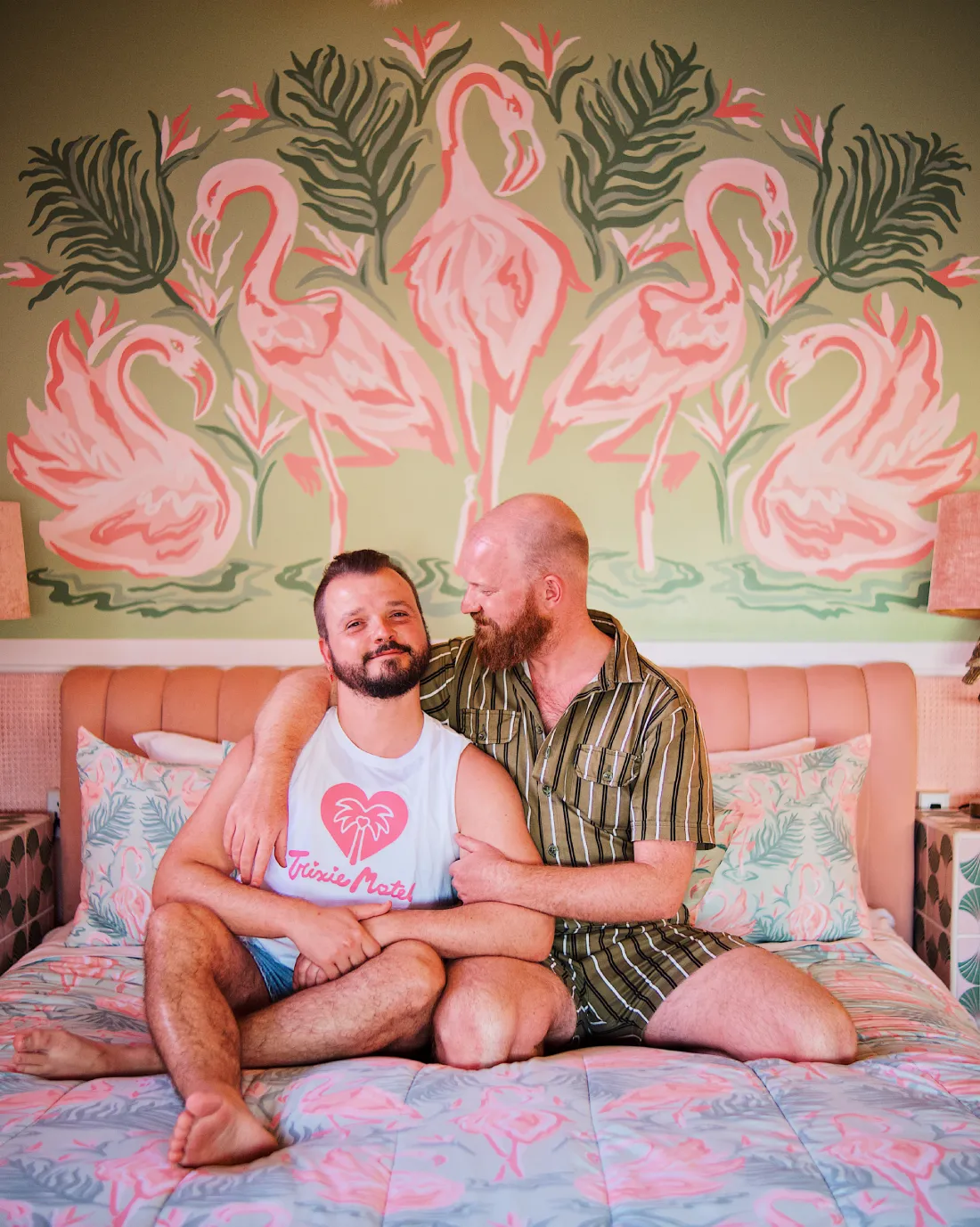
Gay Travel Index 2025
The Berlin-based Spartacus informs LGBTQ+ and queer travelers about how gay-friendly a holiday destination is according to several ranking factors and criteria.
Which country ranks first? Where is it safe to travel to as a gay and LGBTQ+ traveler?
You can use the GTI to prepare for your gaycation and as a guide when choosing a holiday destination.
#8 Non-Binary Pride Flag
The non-binary pride flag was created in 2014 by Kye Rowan, and it consists of four colors: yellow, white, purple, and black. The yellow represents gender outside the binary, the white represents all genders, the purple represents a combination of masculinity and femininity, and the black represents the absence of gender. The gender-diverse flag was designed to represent non-binary individuals and to provide them with a symbol of pride and visibility.
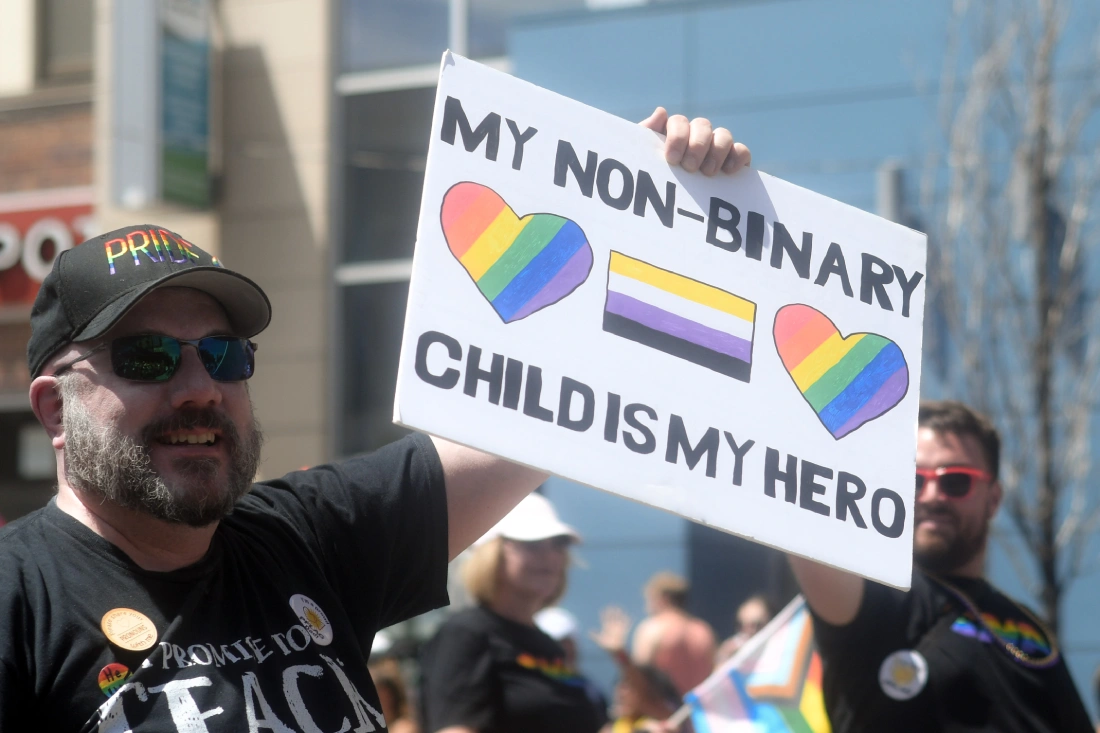
#9 Bisexual Pride Flag
The bisexual pride flag was created in 1998 by Michael Page, the LGBTQ+ pride flag meaning combines pink, purple, and blue to represent same-gender, mixed-gender, and different-gender attraction. The pink represents attraction to the same gender, the blue represents attraction to the other gender, and the purple represents the combination of these two attractions. The flag was designed to represent the fluidity of sexuality and to provide a symbol of pride and visibility for the bisexual community. It’s among the most recognized queer identity flags and remains a staple in Pride celebrations.

Gay Travel Index 2025
The Berlin-based Spartacus informs LGBTQ+ and queer travelers about how gay-friendly a holiday destination is according to several ranking factors and criteria.
Which country ranks first? Where is it safe to travel to as a gay and LGBTQ+ traveler?
You can use the GTI to prepare for your gaycation and as a guide when choosing a holiday destination.
#10 Pansexual Pride Flag
The pansexual pride flag was created in 2010 by Jasper Wilde, and it consists of three colors: pink, yellow, and blue. The pink represents attraction to women, the blue represents attraction to men, and the yellow represents attraction to non-binary people. The flag was designed to represent the pansexual identity, which is characterized by the potential for attraction to people of any gender identity. As gender and sexuality flags evolve, the pansexual flag offers a welcoming symbol for anyone who loves regardless of identity.

#11 Asexual Pride Flag
The asexual pride flag was created in 2010 by AVEN (Asexual Visibility and Education Network), and it consists of four colors: black, gray, white, and purple. The black represents asexuality, the gray represents demisexuality and gray-asexuality, the white represents sexuality, and the purple represents community. The flag was designed to represent the asexual, demisexual, and graysexual communities and to provide them with a symbol of pride and visibility. It’s crucial to understand the diverse spectrum of LGBTQ+ flag meanings.
#12 Two-Spirit Pride Flag
The two-spirit pride flag was created in 2018 by Isaac Murdoch, a two-spirit artist from Canada. The flag has four horizontal stripes of black, white, purple, and brown, with a feather in the center. The flag’s colors represent different aspects of two-spirit identity, including black for Indigenous people, white for the spirit, purple for the mystery, and brown for the land. The feather in the center represents the Two-Spirit people, traditionally seen as having both male and female spirits. It highlights the intersection of cultural and queer Pride symbols.
#13 Polyamory Pride Flag
The polyamory pride flag, created by Jim Evans, is known as the original polyamory pride flag. Since 1995, the flag represents the Polyamorous community, which is a group of individuals who have multiple romantic and/or sexual relationships at the same time. The flag features three colors: blue, representing openness and honesty; red, representing love and passion; and black, representing solidarity with those who must hide their polyamorous relationships. In the center of the polyamory pride flag, Evans placed the Greek letter pi symbol, which symbolizes the infinity of possible relationships. As one of the less mainstream Pride flag designs, it plays a key role in representing relationship diversity within queer communities.
| Flag | Creator | Year |
|---|---|---|
| Rainbow Flag | Gilbert Baker | 1978 |
| Progress Pride Flag (2018) | Daniel Quasar | 2018 |
| Progress Pride Flag (2021) | Valentino Vecchietti | 2021 |
| Transgender Pride Flag | Monica Helms | 1999 |
| Intersex Pride Flag | Morgan Carpenter | 2013 |
| Bear Pride Flag | Craig Byrnes | 1995 |
| Leather Pride Flag | Tony DeBlase | 1989 |
| Lesbian Pride Flag | Natalie McCray | 2010 |
| Non-Binary Pride Flag | Kye Rowan | 2014 |
| Bisexual Pride Flag | Michael Page | 1998 |
| Pansexual Pride Flag | Jasper Wilde | 2010 |
| Asexual Pride Flag | AVEN (community) | 2010 |
| Two-Spirit Pride Flag | Isaac Murdoch | 2018 |
| Polyamory Pride Flag | Jim Evans | 1995 |
LGBTQ+ Activism in the past until now
- Known LGBTQ+ Travel Blogger: The Top List of Queer Travel Bloggers
- Proud and Out loud! Our Gay Pride Trips around the World
- Top List & Overview: All 60+ CSD Parades & Gay Pride Festivals

Which LGBTQ+ Pride Flag should I wear during Pride?
The answer to the question depends on your identity and personal preferences. If you identify with a particular community or identity, wearing that flag can be a meaningful way to show support and pride. Some wear the rainbow to show general queer support, while others choose LGBTQ+ identity flags that represent their personal experiences. Alternatively, you may wear multiple flags to represent your intersectional identity. Ultimately, the most important thing is to wear a flag that speaks to your identity and makes you feel seen and accepted.
Frequently Asked Questions About LGBTQ+ Pride Flags
Each LGBTQ+ Pride flag symbolizes a distinct identity or experience within the queer community. They promote visibility, representation, and solidarity, often using specific color symbolism to communicate values or identity traits.
There are over 50 different Pride flags representing various identities, including gender-diverse flags, romantic orientations, and sexual identities. This article highlights 13 of the most popular LGBTQ+ identity flags.
The classic rainbow flag is a general symbol for LGBTQ+ pride. The Progress Pride flag adds stripes and a chevron to include people of color, transgender individuals, and intersex people, making it a more inclusive Pride symbol.
The flag you wear should reflect your personal identity or the community you support. Some people use multiple flags to express their intersectional identities.
Gilbert Baker, an artist and gay rights activist, designed the original rainbow flag in 1978. It first appeared at the San Francisco Gay Freedom Day Parade.
Yes. As awareness grows, new queer flags are being created to better represent evolving identities, such as the Intersex-Inclusive Progress Pride flag, aromantic flags, and demigender flags.
Colors on each flag are chosen deliberately to reflect different values or identity aspects — for example, pink may stand for love or femininity, yellow for non-binary identity, and black for solidarity.
Yes, allies can wear or display Pride flags to show support, especially more inclusive versions like the Progress Pride flag, but should do so respectfully and with awareness of their meaning.
You can find the most important LGBTQ+ Pride flags on our blog coupleofmen.com. Alternatively, a comprehensive guide is available online, or you can visit LGBTQ+ advocacy websites that list and explain all known queer identity flags and their meanings.
Debates arise around inclusivity, design, and historical representation. For example, some felt the Progress Pride flag altered the unity of the original rainbow design, while others welcomed its emphasis on marginalized identities.
The Power of Pride Flags
Pride flags are not just symbols — they are statements of empowerment, belonging, and love. As the LGBTQ+ community continues to evolve and diversify, so do the flags that represent it. Whether you proudly wave the classic rainbow flag or feel a deep connection to the intersex, transgender, lesbian, or polyamory flags, your choice reflects both personal identity and community solidarity.
Choosing a flag for Pride or any occasion is ultimately about expressing who you are and honoring the collective strength of queer voices worldwide. The beauty of these LGBTQ+ Pride flag meanings lies in their ability to unite us while celebrating our unique differences. Keep learning, stay visible, and don’t be afraid to fly your flag with pride.
For more travel news from and background on the LGBTQ+ community, follow Couple of Men on Instagram, Threads, YouTube, Pinterest, and Facebook!
Karl & Daan.
Do you like the article?
Please share it on Pinterest!


